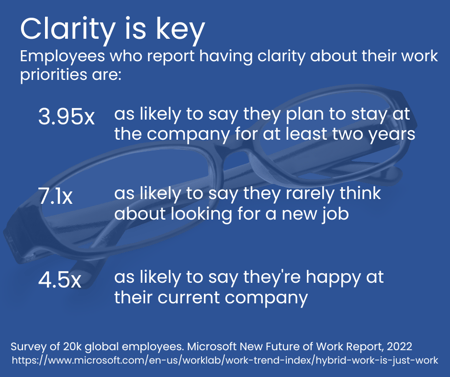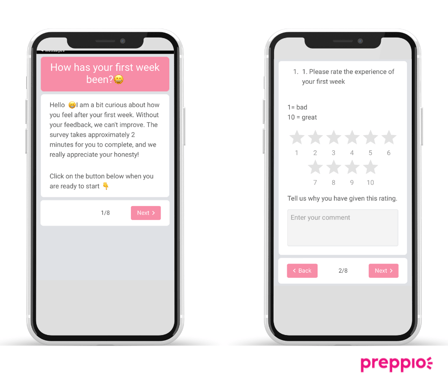How important are the 6 C's of onboarding in the future of work? Microsoft has released a treasure trove of research on the new era of work since the pandemic shutdown. We combed through the research to learn about the role of onboarding in a post-pandemic world. As it turns out - the 6 C's of onboarding is just as essential in the new future of work as it is now. Following is a C by C breakdown and how you can integrate them into your employee onboarding process. Plus free template downloads to help get your onboarding process started.
Microsoft is Shaping the Future of Work
Microsoft seized the opportunity to learn about workplace dynamics when offices around the world shut down amid the Covid-pandemic. Its analytics team gathered thousands of data points related to the impact of workplace changes on employee productivity, engagement, wellness, collaboration, and more.
The New Future of Work Initiative was created for Microsoft to not only only gain an understanding of the impact of the pandemic on employees, but also to shape the future of the global workplace. With the added resources from its acquired companies, LinkedIn and GitHub, the initiative has unprecedented access to people analytics.
Combined with the scientific literature on new work technology and practices, the result is a mega repository of data on the future of work. Microsoft’s goal of the initiative is to create “a future of work that is meaningful, productive, and equitable.”
What are the 6 C’s of employee onboarding?
The 6 C’s of employee onboarding is essential for any HR professional or organization leader to know. It forms the building blocks of an effective employee onboarding process. The 6 C’s framework was developed through years of research by Talya Bauer, Ph.D., Chief Scientific Officer of Preppio.
Read more about the 6 C’s of onboarding
You can think of the 6 C’s as forming a pyramid that progresses upward, as shown in the graphic below. Starting from the bottom of the pyramid is the most basic component of onboarding that all organizations have in one form or another: Compliance.
Moving up the pyramid is Clarification, Confidence, Connection, and Culture. Checkback occurs throughout the onboarding process to gather feedback about all aspects of the onboarding experience.
Onboarding maturity, which is correlated with employee retention and engagement, grows as organizations progress up the pyramid by implementing these components of onboarding into their process.
The 6 C’s in Microsoft's New Future of Work
Microsoft’s research reveals that the 6 C’s of onboarding are not only relevant in the new future of work - but more important than ever. Read on for a quick summary of findings for each of the C’s. And most importantly, actionable takeaways to implement in your organization.
Compliance
Compliance includes the housekeeping items of onboarding such as new hire paperwork and mandatory videos. The essential but boring stuff that characterized first-day orientations years ago.
The absence of compliance in Microsoft’s surveys and feedback is a notable point in itself. Though this shouldn’t come as a surprise. Compliance is the first “C” at the bottom of the pyramid of the 6 C’s of onboarding. It is a behind-the-scenes necessity that creates a positive employee experience when least visible.
Actionable takeaway: Make compliance-related activities as quick and seamless as possible to make the first day a positive, memorable experience.
- Send forms needing a signature before the first day.
- Make it easy by offering fillable forms with electronic signatures.
- Pre-fill the forms with as much information as possible.
- Minimize duplicated information requests.
Clarification
Have you ever felt unclear about what to expect after signing an offer letter for a new position? If so, your new employer did not provide strong clarification about what to expect leading up to the first day and beyond.
Lack of clarity around roles and responsibilities is frequently cited as a contributing factor along the entire employee lifecycle, from onboarding and well past full productivity. Microsoft’s research validates that this is a critical factor in employee satisfaction.
Dawn Klinghoffer, Microsoft's Head of People Analytics, said “Our data show that new hires who are clear about what’s expected of them had a better onboarding experience. Less was left on the table." [1]

Actionable takeaway: Remember that new hires are in a state of uncertainty. Strengthen clarification by providing clear expectations.
- Provide a two-week onboarding outlook schedule on day one.
- Email an organizational hierarchy chart and “who to contact” list before day one.
- Leave no guesswork about where to go (in person or virtually) on the first day.
- Invite new hires to company intranet sites that provide more clarity around roles, responsibilities, organization initiatives, and other information.
Download a fully customizable employee onboarding plan template, from pre-boarding thru six months.
Confidence
It is easy to feel lost in the first days and weeks of a job. Clarification helps to prevent some of the uncertainty, but more is needed to feel confident. Confidence is about doing the job well and feeling competent to tackle new challenges.
In addition to clear expectations, confidence is boosted by certainty about meeting or exceeding performance goals. According to Microsoft’s research, the most basic thing managers can do to foster an environment conducive to well-being is to, “Help their teams understand what work is most important—in a word, help them prioritize."[2]
When employees feel more confident, they are more likely to have positive attitudes about their team, as well as the choice to join your organization.
Actionable takeaway: Build up employee confidence by providing them the tools and resources to navigate their new positions during the first weeks and months on the job while supporting individuality.
- Help to prioritize tasks.
- Celebrate successes.
- Integrate individual strengths into projects.
Read more about how Microsoft coaches managers for onboarding
Connection
Have you ever started the first day on a job and felt nameless or invisible? Maybe even like you were a burden interrupting your new co-worker’s schedule.
Conversely, if you were met with a personalized greeting and welcomed with gratitude for your arrival, then you probably felt an immediate connection with your new colleagues. Connection refers to how accepted and valued new employees feel. It’s all about relationships in the workplace.
Microsoft points to the importance of connection time and time again. That is, the depth of the relationship between employees and managers as well as across teams.

"The biggest, biggest thing we found is the direct connection to your immediate manager," said Satya Nadella, CEO and Chairman of Microsoft, regarding company success with the move to remote and hybrid models.[3]
What Microsoft found was that connection begets connection. In other words, the more connected employees feel with their managers, the more connected they feel to their team and the organizational culture.
Actionable takeaway: Begin developing connection in the pre-boarding phase of onboarding.
- Record and send a video of the team.
- Remind managers to send a personal welcome message following the offer letter.
- Send an introduction video from the CEO.
Culture
In the 6 C’s of onboarding Culture refers to how well new employees understand their new organization’s norms, values, stories, and symbols.
By the time a new hire signs the job offer they have already begun to develop an idea of the organizational culture. The onboarding process either validates or challenges their developing attitudes.
In its 2022 New Future of Work report, Microsoft describes culture as “a leading driver of the Great Reshuffle” and people’s decisions to seek new jobs.[4] The report references “The Toxic Five” attributes that have the most negative impact on perceptions of company culture:
- Disrespectful: Lack of consideration, courtesy, and dignity for others.
- Non-inclusive: Inequity in the areas of LGBTQ, disability, race, age, gender, and cronyism or nepotism.
- Unethical: Dishonesty, lack of regulatory compliance, and general unethical behavior.
- Cutthroat: Backstabbing behavior and ruthless competition.
- Abusive: Bullying, harassment, and hostility.
Microsoft suggests that managers create a supportive work environment where their people love the work and feel they have a work-life balance.
Actionable takeaway: The onboarding phase is an opportunity to acclimate new hires to the culture and stay aware of indicators of misalignment between desired culture and actual experience.
- Incorporate the organization’s mission and values into the onboarding process.
- Share about the founding story so that new hires understand the history.
- Provide ways for new hires to share ideas and grievances so that the organization can evolve for the better.
Checkback
Employee onboarding is a constantly evolving process that should be altered as needed based on onboarding stakeholder feedback. Checkbacks refer to checking back with employees, managers, HR, and work buddies to determine what went well and what could use improvement in the onboarding process.

Microsoft’s people analytics team concluded, "A solid system for listening to employees will help leaders tap into the evolving needs of their workforce."[5]
Microsoft’s first New Future of Work report published in 2021 was entirely based on surveys from 150k employees. It was this data that validated what Microsoft had done well and what required revision.
One thing Microsoft learned was to keep surveys frequent but brief to get the most accurate information and avoid survey burnout among employees.
Actionable takeaway: Keep checkbacks brief but consistent and remember to follow-thru by continuing to evolve the onboarding process based on feedback.
- Start checkbacks on day one with a brief survey for employee feedback.
- Use technology to deliver fun and easy-to-take surveys.
- Integrate existing communications platforms into the survey process for convenience.

Launch your onboarding program in a week
Rome wasn’t built in a day and your employee onboarding program won’t be perfect in a week. But the only way to get there is to begin. Start with the basics and build it from there based on knowledge and data gained along the way. Read our six-step guide to launch your onboarding program in less than a week to get started right away. We have lined out the basic steps and incorporated the 6 C’s of onboarding to get you off to a strong start.
Have a question about onboarding?
It can be daunting to get an onboarding process off the ground. Preppio's onboarding experts are here to help. Just drop us a line.
References
[1] https://www.microsoft.com/en-us/worklab/work-trend-index/managers-keep-teams-connected
[2] https://www.microsoft.com/en-us/worklab/work-trend-index/managers-keep-teams-connected
[3] https://www.microsoft.com/en-us/worklab/satya-nadella-talks-to-adam-grant-about-the-future-of-work
[5] https://www.microsoft.com/en-us/worklab/work-trend-index/managers-keep-teams-connected
.png?width=453&height=380&name=Preppio%206%20Cs%20(1).png)
